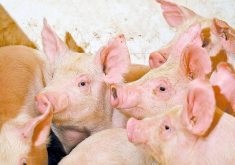By the time an actual sample of the H7N9 virus arrived in U.S. labs, scientists had already used its genetic code to make a synthetic version and begun work on a vaccine
Reuters / Even before they got a sample of the new bird flu virus from China — typically the first step in making a flu vaccine — U.S. researchers had already begun testing a “seed” strain of the virus made from the genetic code posted on the Internet.
This new, faster approach is the result of a collaboration among the U.S. government, vaccine maker Novartis and a unit of the J. Craig Venter Institute, which is using synthetic biology in which scientists take the genetic code of the virus and use it as a recipe to build the virus from scratch.
Read Also

Horns aren’t unlocking anytime soon on livestock transport standards
Standards good enough meet the definition of “humane” animal transportation still vary widely between what what industry wants, what animal rights advocates want and, between the two, what federal regulators decide is good enough.
It was an idea born in the aftermath of the 2009 H1N1 pandemic, in which production delays and poor-quality seed strain slowed delivery of the vaccine until October, late enough that people were already sick with swine flu.
The new method has shaved two weeks off the vaccine-making process. It will take five to six months to ramp up production, but even weeks could make a difference in the case of a potentially deadly flu pandemic, said Robin Robinson, director of the federal government’s Biomedical Advanced Research and Development Authority.
“We’ll take it,” Robinson said. “If the virus turns out to be a tough one, that could be very important.”
So far, at least 33 people have been infected and 10 have died from the strain of bird flu, known as H7N9, was first found in humans last month.
When the genetic sequence for the virus became available on March 30, Robinson said U.S. health officials decided to try the new synthetic biology technique to try to speed the process. That’s when Novartis and Venter’s company, Synthetic Genomics Vaccines Inc., went to work. By April 4, they had synthetic DNA ready and had started to grow the virus in dog kidney cells.
A sample of the virus collected in China only arrived in the U.S. in early May. Scientists will now grow that sample and then find a way to ensure it will grow well in chicken eggs or cells.
That involves a certain amount of guesswork, however. The new process of building the virus based on its genetic code allows “almost guaranteed success,” said Mike Shaw, director of the U.S. Centers for Disease Control and Prevention.
“That is because you’re creating a virus that is almost tailor-made,” he said.














